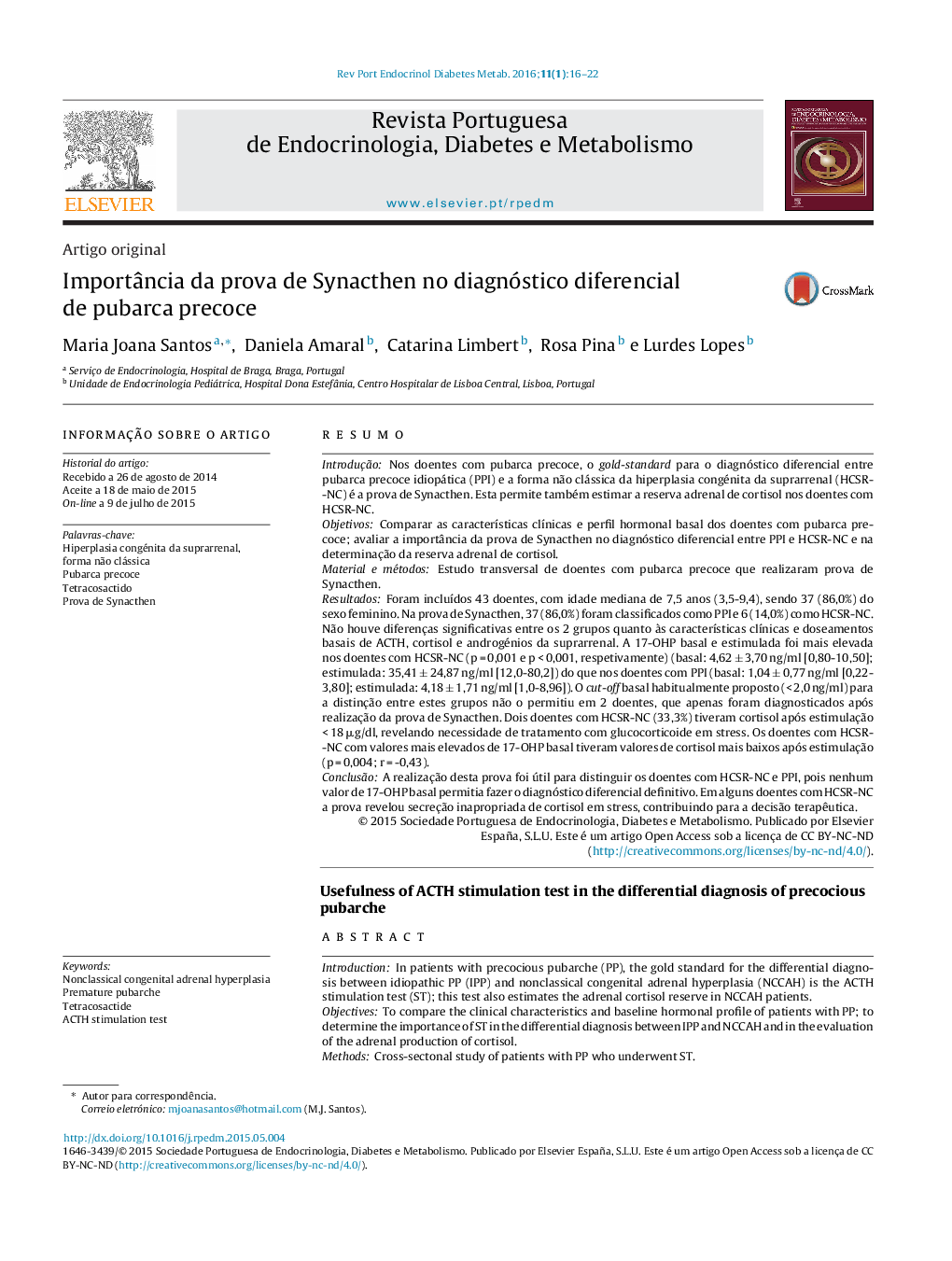| Article ID | Journal | Published Year | Pages | File Type |
|---|---|---|---|---|
| 3278222 | Revista Portuguesa de Endocrinologia, Diabetes e Metabolismo | 2016 | 7 Pages |
ResumoIntroduçãoNos doentes com pubarca precoce, o gold‐standard para o diagnóstico diferencial entre pubarca precoce idiopática (PPI) e a forma não clássica da hiperplasia congénita da suprarrenal (HCSR‐NC) é a prova de Synacthen. Esta permite também estimar a reserva adrenal de cortisol nos doentes com HCSR‐NC.ObjetivosComparar as características clínicas e perfil hormonal basal dos doentes com pubarca precoce; avaliar a importância da prova de Synacthen no diagnóstico diferencial entre PPI e HCSR‐NC e na determinação da reserva adrenal de cortisol.Material e métodosEstudo transversal de doentes com pubarca precoce que realizaram prova de Synacthen.ResultadosForam incluídos 43 doentes, com idade mediana de 7,5 anos (3,5‐9,4), sendo 37 (86,0%) do sexo feminino. Na prova de Synacthen, 37 (86,0%) foram classificados como PPI e 6 (14,0%) como HCSR‐NC. Não houve diferenças significativas entre os 2 grupos quanto às características clínicas e doseamentos basais de ACTH, cortisol e androgénios da suprarrenal. A 17‐OHP basal e estimulada foi mais elevada nos doentes com HCSR‐NC (p = 0,001 e p < 0,001, respetivamente) (basal: 4,62 ± 3,70 ng/ml [0,80‐10,50]; estimulada: 35,41 ± 24,87 ng/ml [12,0‐80,2]) do que nos doentes com PPI (basal: 1,04 ± 0,77 ng/ml [0,22‐3,80]; estimulada: 4,18 ± 1,71 ng/ml [1,0‐8,96]). O cut‐off basal habitualmente proposto (< 2,0 ng/ml) para a distinção entre estes grupos não o permitiu em 2 doentes, que apenas foram diagnosticados após realização da prova de Synacthen. Dois doentes com HCSR‐NC (33,3%) tiveram cortisol após estimulação < 18 μg/dl, revelando necessidade de tratamento com glucocorticoide em stress. Os doentes com HCSR‐NC com valores mais elevados de 17‐OHP basal tiveram valores de cortisol mais baixos após estimulação (p = 0,004; r = ‐0,43).ConclusãoA realização desta prova foi útil para distinguir os doentes com HCSR‐NC e PPI, pois nenhum valor de 17‐OHP basal permitia fazer o diagnóstico diferencial definitivo. Em alguns doentes com HCSR‐NC a prova revelou secreção inapropriada de cortisol em stress, contribuindo para a decisão terapêutica.
IntroductionIn patients with precocious pubarche (PP), the gold standard for the differential diagnosis between idiopathic PP (IPP) and nonclassical congenital adrenal hyperplasia (NCCAH) is the ACTH stimulation test (ST); this test also estimates the adrenal cortisol reserve in NCCAH patients.ObjectivesTo compare the clinical characteristics and baseline hormonal profile of patients with PP; to determine the importance of ST in the differential diagnosis between IPP and NCCAH and in the evaluation of the adrenal production of cortisol.MethodsCross‐sectonal study of patients with PP who underwent ST.Results43 patients were included; median age at diagnosis was 7.5 years [range: 3.5‐9.4], 37 (86.0%) were female. After ST, 37 (86.0%) were classified as IPP and 6 (14.0%) as NCCAH. No significant differences could be found in the clinical characteristics and baseline determination of ACTH, cortisol and adrenal androgens between the groups. Both basal and stimulated 17‐OHP levels were significantly higher (p = 0.001 and p < 0.001, respectively) in NCCAH patients (basal: 4.62 ± 3.70 ng/ml [0.80‐10.50]; stimulated: 35.41 ± 24.87 ng/ml [12.0–80.2]) than IPP patients (basal: 1.04 ± 0.77 ng/ml [0.22–3.80]; stimulated: 4.18 ± 1.71 ng/ml [1.0–8.96]). Nevertheless, the proposed basal cut‐off level (< 2.0 ng/ml) for the distinction between the groups, did not allow for this in 2 NCCAH patients that were only diagnosed after ST. Two NCCAH patients (33.3%) had stimulated cortisol levels < 18 μg/dl, showing the need for glucocorticoid stress therapy. NCCAH patients with higher initial 17‐OHP value had lower cortisol after stimulation (p = 0.004; r = ‐0.43).ConclusionThe ST was useful to distinguish between patients with NCCAH and IPP, for no basal 17‐OHP level could allow for a definitive differential diagnosis in the individual patient. In some NCCAH cases, it also showed inappropriate cortisol secretion under stress, contributing to the therapeutic decision.
